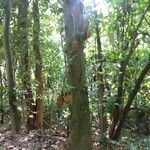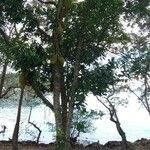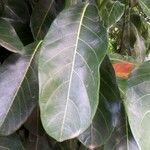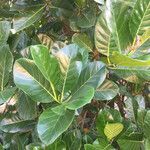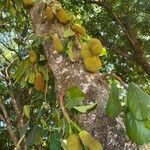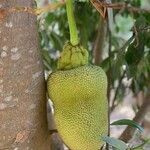Trees 10-20 m tall, d.b.h. 30-50 cm, evergreen. Mature trees with tubular roots. Bark blackish brown, thick. Branchlets furrowed to smooth, 2-6 mm thick, glabrous. Stipules amplexicaul, ovate, 1.5-8 cm, with or without bent pubescence, caducous, scar annular and conspicuous. Leaves spirally arranged; petiole 1-3 cm; leaf blade elliptic to obovate, 7-15(or more) × 3-7 cm, lobed on new growth of young trees, leathery, abaxially pale green and with scattered globose to ellipsoid resin cells, adaxially dark green, glabrous, and shiny, base cuneate, margin of mature leaves entire, apex blunt to acuminate; midvein abaxially conspicuously prominent, secondary veins 6-8 on each side of midvein; leaves on mature trees entire. Inflorescences on old stems or brachyblasts. Male inflorescences axillary on apical branchlet, sometimes axillary on axillary brachyblasts, cylindric to conic-ellipsoid, 2-7 cm, many-flowered but some sterile; peduncle 1-5 cm. Female inflorescences with a globose fleshy rachis. Male flowers: calyx tubular, apically 2-lobed, 1-1.5 mm, pubescent; filament straight in bud; anther ellipsoid. Female flowers: calyx tubular, apically lobed; ovary 1-celled. Fruiting syncarp pale yellow when young, yellowish brown when mature, ellipsoid, globose, or irregularly shaped, 30-100 × 25-50 cm, with stiff hexagonal tubercles and thick hairs. Drupes narrowly elliptic, ca. 3 × 1.5-2 cm. Fl. Feb-Mar.
Evergreen tree to 20 (–25+) m high, monoecious, with milky white exudate in the bark, branchlets and petioles. Leaves alternate, simple; lamina elliptic to obovate or elliptic-oblong, (5–) 14–25 cm long, (3–) 8.5–12 cm wide, cuneate base, entire margin (or in young plants often with 1 or 2 pairs of lobes), rounded to ± truncate often with a short, pointed tip at apex, dark green and shiny above, dull paler green underneath; petiole 1–3 (–4) cm long. Stipules sheathing the terminal bud, amplexicaul, to 8 cm long, caducous leaving conspicuous circular scar around stem. Inflorescences unisexual, produced on lateral shoots on the stem and branches. Flowers sessile; tepals 2, minute, green, white or cream; stigmas clavate. Fruits a multiple fruit (syncarp), barrel-to pear-shaped, large and heavy, 20–100 cm long, 20–50 cm wide, green, yellow or orange, knobly-warty or spiny (sharp conical warts), exuding a sticky milky exudate when cut, particularly when immature. Seeds numerous, oblong-ellipsoid, to 4 cm long, surrounded by waxy, firm or soft, golden yellow, fleshy perianths. For more detailed description, including the inflorescence and flowers, see Wu et al. (2003) and Slik (2009).
An evergreen tree up to 20 m tall and in the breadfruit family. Trees form many branches but have one or two main trunks. The bark is smooth and dark green. Leaves of young trees have 1 or 2 lobes but mature leaves are long (15 cm) and entire. They are leathery, deep green and glossy. Flowers occur on spikes, on stalks from the trunk or main branches. Some stalks only have male flowers, others only have female flowers while some have both male and female spikes. Generally male flowers are on short stalks among the leaves, and female flowers are on trunks. Male flowers are 5 cm long by 2 cm wide and are dull green. Female flowers are bright green. The very large spiny fruit grow on main branches and the trunk. The fruit is a composite fruit made up from the many individual flowers of the flower cluster. Fruit can be 1 m long and weigh 36 kg. They have 6 sided fleshy spines. Each seed is surrounded by a yellow fleshy sheath. Seed are 2-4 cm long and 1-2 cm wide. There can be 100-500 seed in a fruit. Unlike breadfruit, there are no seedless Jackfruit. When ripe the unopened fruit has a strong smell.
Tree up to 1 tall. Stipules 1.5-8 cm long; blade elliptic to obovate, up to 25 x 10 cm, entire. Inflorescences mostly on the trunk and main branches. Staminate inflorescences clavate, up to 10 cm long. Pistillate inflorescences ellipsoid to globose, in fruit 30-60(-100) cm long, covered with conical processes.
Tree.. Lamina ± 10–20 × 6–10 cm., entire.. Inflorescences on the main branches and the trunk.
A tree.
